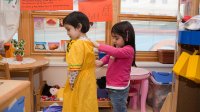A Culture of Kindness in Early Childhood Classrooms
Encouraging kindness in the early grades helps children develop behaviors that have value far beyond their school years.
Your content has been saved!
Go to My Saved Content.Whether kindness is innate or not, being purposeful about teaching it definitely contributes to a positive classroom culture. When you focus on kindness, you send the message of its value in your classroom community. Modeling and encouraging kind behavior and reflecting on its presence in your classroom can create an environment of care. Prioritizing kindness helps children see the impact of the words they use and actions they take on the dynamics of the classroom.
Furthermore, children who learn to treat others with respect and generosity in their classroom community can carry these values outside the classroom and throughout their lives. Recent research suggests that acts of kindness in our classrooms have meaningful ripple effects in our larger communities—in other words, kindness is contagious.
5 Ways to Spread Kindness in Your Class
1. Build on children’s knowledge: Activate children’s personal experiences with kindness by making it an explicit topic of conversation. Hold class discussions in which you ask children to describe kind acts they have performed and received. What does acting kindly look like? What do kind words sound like? How does kindness feel inside?
Invite children to contribute ideas for the behaviors they want to embrace to keep their classroom a safe, fair, and caring place. Capture their ideas on an anchor chart that you co-create and continually revisit and revise. This living document reinforces that every community member is responsible for the well-being of the whole group.
2. Make it public: Be intentional about noticing, recalling, and reflecting on acts of kindness that occur in the classroom. When you observe children being caring, offer specific feedback by telling them exactly what they did and draw out how it positively affected another person. Celebrate and showcase children’s kind acts in your environment.
For example, if you witness a child sharing crayons with a classmate who also wanted to use them, ask if you can take a photo to capture this act of kindness. With the children’s input, caption the photo and post it in your room. Or, make a “kindness tree” on which children’s names get added as “leaves” when they act kindly.
By emphasizing children’s positive contributions, you show them how they can nurture a culture of kindness.
3. Give children practice: Like any skill that children are developing, being kind takes practice, so give children lots of it. Provide varied opportunities for children to be helpful to one another and work cooperatively.
One powerful method for doing this is using puppets to role play “How can we help?” stories. Pose a problem and invite children to offer suggestions for how to respond. Give them time to rehearse what words they would use in this situation. For example, act out having one of your class puppets fall down and hurt their knee. Then ask children to brainstorm and act out what they could say and do to take care of the puppet. This type of practice gives children a safe forum to try out their ideas and prepares them for real-life encounters.
4. Use children’s literature: High-quality children’s books can spark robust discussions around kindness. Invite children to talk about ways characters act in books. For example, in Jabari Jumps, Jabari feels afraid to jump off the diving board, but his father’s gentle support gives him the confidence to do it. Pose open-ended questions to probe children’s thinking. How does Jabari’s father act kindly? How would you have helped Jabari?
Conversely, in Little Blue Truck, the dump truck does not act kindly toward Blue when he speeds harshly past him. Prompt children to think about how they might act in a similar scenario or what they might say to encourage more kindness. What is a more caring way to treat Blue? How could the dump truck be more helpful to others? Conversations like this allow children to internalize kind choices, which they can apply to situations in their own lives.
5. Kindness takes mindfulness: If children are aware and mindful of their own emotions, they may be more likely to be aware and mindful of other people’s emotions, as well. This broader awareness fosters more empathy and consideration of different perspectives.
Teach children mindfulness exercises so that they can visualize how it feels to receive kindness and to share it with others. You can have children sit comfortably and take several deep breaths. Invite them to imagine how kindness feels inside their hearts. As they breathe in, guide them to feel the kindness grow bigger. As they breathe out, ask them to send kindness out to everyone in their community.
Make connections between children’s kind acts and the creation of a more positive community, both inside the classroom and outside of it. Instilling the value that each and every person is worthy of respect, care, and kindness fosters the sort of cultural equity that we seek to extend far beyond the classroom.
